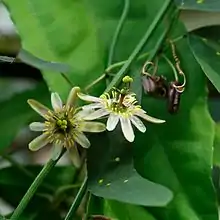Passiflora biflora
Passiflora biflora, the twoflowered passionflower, is a vine with paired peduncles and flowers up to 3.5 cm (1.4 in) wide. It is native to the New World from Mexico to Colombia and Venezuela.[1] In Florida, P. biflora has been classified by the Exotic Pest Plant Council as a non-native species that has the "potential to disrupt native plant communities."[2][3]
| Passiflora biflora | |
|---|---|
 | |
| Scientific classification | |
| Kingdom: | Plantae |
| Clade: | Tracheophytes |
| Clade: | Angiosperms |
| Clade: | Eudicots |
| Clade: | Rosids |
| Order: | Malpighiales |
| Family: | Passifloraceae |
| Genus: | Passiflora |
| Species: | P. biflora |
| Binomial name | |
| Passiflora biflora | |
Uses
Van den Bergh 1994 and Ochse & van den Brink 1980 report the flowers are eaten in Indonesia and Malaysia.[4]: 34
References
- Krings, A., and R.R. Braham. 2005. Guide to Tendrillate Climbers of Costa Rican Mountains. Ames, Iowa: Blackwell Publishing. pp. 94-96.
- Wunderlin, R.P., and B.F. Hansen. 2008. Passiflora biflora. Atlas of Florida Vascular Plants, Institute for Systematic Botany, University of South Florida, Tampa. Accessed online: 31 March 2014.
- "Passiflora biflora Lam".
- Lim, Tong (2014). Edible Medicinal and Non Medicinal Plants. Vol. 8. Dordrecht: Springer Science and Business Media LLC. pp. xiii+1024. ISBN 978-94-017-8747-5. LCCN 2014936737. OCLC 878641531. ISBN 978-94-017-8748-2.
This article is issued from Wikipedia. The text is licensed under Creative Commons - Attribution - Sharealike. Additional terms may apply for the media files.